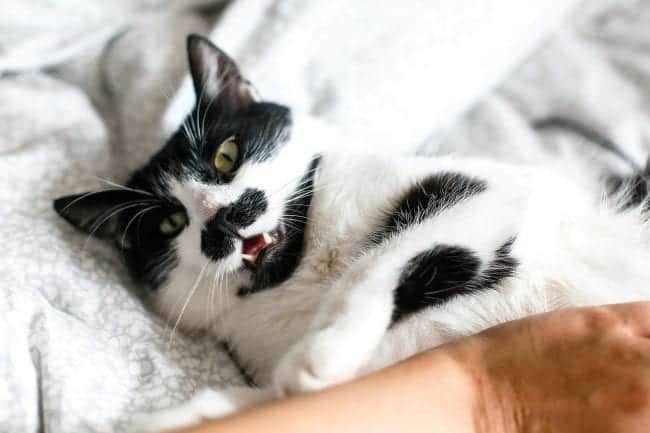If you have a feline friend in your life, it goes without saying that you pet your cat every single day. Lovingly stroking their fur has been proven to be beneficial to your health, and seeing as your cat’s sense of touch is much more heightened than ours, your cat loves it! While we know that cats do not like to be pet on their belly, the reason is that this area is highly sensitive to touch and will cause them to react should they become overstimulated. The base of the tail is another no-go for most cats, as the sensitive nerve endings there can transform them from happiness to anger in two seconds flat.
Almost all cats can agree, don’t you dare pet my belly!
National Geographic recently polled their readers on quirky cat behaviors, and Lena Provoost, an animal behaviorist at the University of Pennsylvania School of Veterinary Medicine, weighed in on the topic of feline-preferred petting regions:
“Cats prefer to be pet and scratched on the head, specifically under their chin and cheeks where they have scent glands.”
I think we’ve all been victim to cat bites, or at least I know I have when I wasn’t as wise to the ways of the feline mind. To pet your cat properly, it boils down to mutual understanding, and above all, respect for your cat. We know that cats are highly sensitive beings, and the slightest touch can send them to the dark side and leave you with some not-so-friendly reminders.
The power of understanding your cat’s body language
Lauren Finka, Postdoctoral Research Associate at Nottingham Trent University and writer for TheConversation.com, recently covered this hot topic in the feline world to share with cat owners that understanding your cat’s body language is the key to petting your cat the best way. “Although a lot of cats do like being stroked, and in certain contexts will choose us over food, human interaction is something they have to learn to enjoy during their comparatively short sensitive period– between two and seven weeks old. When it comes to human-cat interactions, the characteristics of humans are also important. Our personalities and gender, the regions of the cat’s body we touch, and how we generally handle cats, may all play an important role in how the cat responds to our affections. And while some cats may react aggressively to unwanted physical attention, others may merely tolerate our social advances in exchange for the good stuff (food and lodgings). That said, a tolerant cat is not necessarily a happy cat. Higher stress levels are reported in cats that are described by their owners as tolerating rather than actively disliking petting.”
The purrfect way to pet your cat
We aren’t trying to tell you exactly what you can and cannot do, but showing your cat that you understand them speaks volumes to them and establishes trust. Your cat will see that you’ve taken notice of what areas of their body to avoid, and trust us, they’ll thank you for it!
In terms of decoding cat body language, Finka shares what to watch for:
Signs of cat enjoyment: Tail held upright and choosing to initiate contact. Purring and kneading you with their front paws. Gently waving their tail from side to side while held in the air. A relaxed posture and facial expression, ears pricked and pointed forwards. Giving you a gentle nudge if you pause while you’re stroking them.
Look, but don’t touch, human!
As we mentioned above concerning the base of the cat’s tail and their belly, the back region is sometimes a no-go in terms of stroking/petting. See below for Finka’s recommendations on cat body language that can equal your cat lashing out due to displeasure. Signs of dislike or tension: Shifting, moving, or turning their head away from you. Remaining passive (no purring or rubbing) Exaggerated blinking, shaking their head or body or licking their nose Rapid, short bursts of grooming. Rippling or twitching skin, usually along their back. Swishing, thrashing or thumping tail. Ears flattening to the sides or rotating backward. A sharp sudden turn of their head to face you or your hand. Biting, swiping, or batting your hand away with their paw. 







